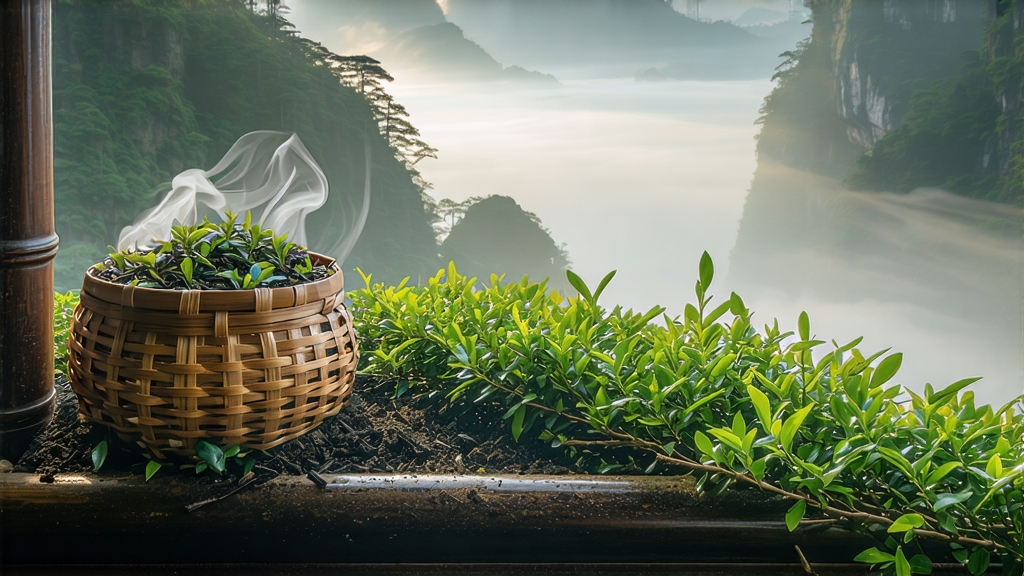
Ask most tea lovers to name China’s oldest black tea and the answer is the same: Lapsang Souchong. Born in the cool, mineral-rich folds of the Wuyi Mountains of northern Fujian, this rugged leaf was the first black tea ever documented, the catalyst that launched the global craving for “bohea” in the seventeenth century, and the prototype for every smoky Earl Grey twist still poured from London to Louisiana. Yet beyond its campfire aroma lies a nuanced story of imperial edicts, Dutch carracks, pine forests, and meticulous craft that turns a humble camellia leaf into liquid mahogany.
History: From Misty Crags to European Courts
Local legend dates the birth of Lapsang Souchong to 1568, late in the Ming Dynasty, when a passing army commandeered Tongmu village, delaying the usual green-tea drying schedule. To save the harvest, farmers rushed the oxidizing leaves over open pine fires, inadvertently creating a dark, fragrant tea that traveled down the Nine-Bend River to the port of Xiamen. Dutch traders christened it “bohea,” a corruption of “Wuyi,” and by 1604 European auction records already list “Lapsang” at prices higher than silver. The East India Company later planted Assam and Ceylon gardens precisely to imitate this Chinese original, making Lapsang Souchong the genetic and commercial ancestor of the entire black-tea world.
Terroir: Why Only Tongmu Tastes Like Tongmu
The Wuyi range is a UNESCO geopark of weathered granite cliffs, narrow gorges, and a subtropical monsoon climate that traps cloud cover for two-thirds of the year. Day-night temperature swings of 15 °C slow leaf growth, concentrating polyphenols and volatile oils. Crucially, the village of Tongmu sits inside a national nature reserve where only indigenous pine species (Pinus massoniana and Pinus taiwanensis) may be harvested for fuel. The resinous heartwood imparts the unmistakable terpene note—part incense, part whisky barrel—that no outsider has successfully replicated. Attempts to smoke cheaper leaf in Guangdong or India yield harsh, creosote-heavy cups lacking the honeyed finish that balances the pine.
Cultivars: Three Faces of Souchong
Although Western retailers often use “Lapsang” as a catch-all, connoisseurs recognize three distinct styles, all built from the same small-leaf Wuyi cultivar group known as cai cha.
- Traditional Pine-Smoked Lapsang: The original. After withering, rolling and full oxidation, leaves are spread on bamboo trays suspended over a pinewood pit fire. A final high-temperature bake locks in the signature tarry sweetness.
- Wuyi Smoked Zheng Shan Xiao Zhong: A subtler, more recent innovation using only young spring buds and cooler smoke; favored in domestic Chinese markets for its clean, cocoa-laced liquor.
- Unsmoked Zheng Shan Xiao Zhong: Crafted for the modern palate—no pine fire, only charcoal baking. The cup is burgundy-amber, redolent of longan fruit and roasted sweet potato, proving that the leaf itself carries innate Wuyi character independent of smoke.
Craft: A Day in the Tea Master’s Shed
Harvest begins at dawn on Qingming Festival, when two leaves and a bud are still dewy. The goal is 45 % moisture reduction during a six-hour indoor wither on slatted bamboo racks above a gentle charcoal ember—no flames, just circulating warm air. Once the leaf loses its grassy edge, rollers knead 3 kg batches for 25 minutes, rupturing cells to invite oxygen. Oxidation proceeds in cedar-lined trays kept at 24 °C and 85 % humidity; color shifts from jade to copper in about two hours. The critical decision comes at the smoking stage: only pinewood that has seasoned for six months is lit, then smothered to create a cool, aromatic smoke (28–32 °C). Masters “read” the plume the way a vintner reads must; too hot and the tea tastes kerosene, too cool and mold threatens. Three successive firings, each shorter and hotter, finish the tea around midnight. By dawn the leaves have lost 80 % of their weight, curled into glossy black twists that rattle like obsidian twigs.
Grading: From P